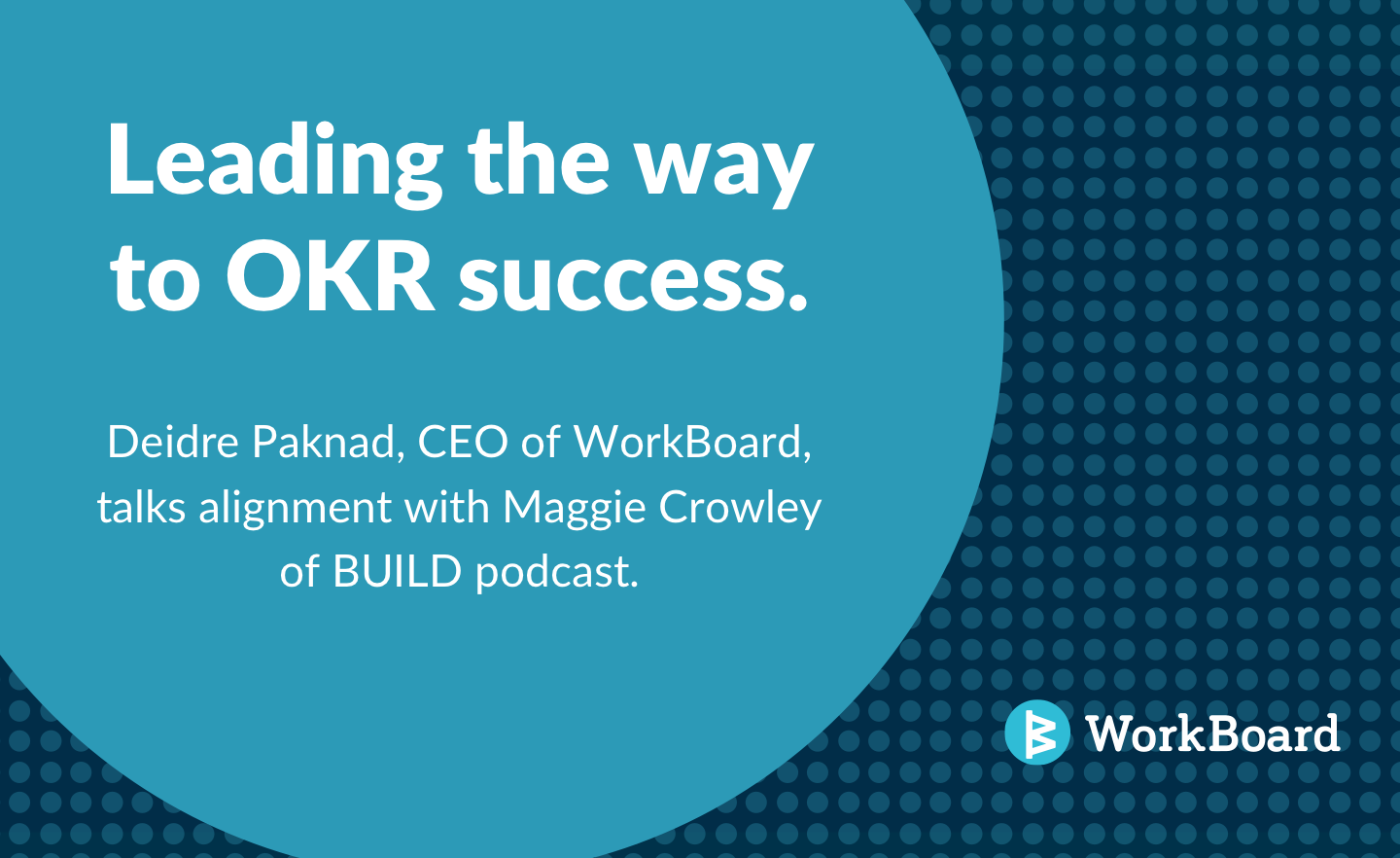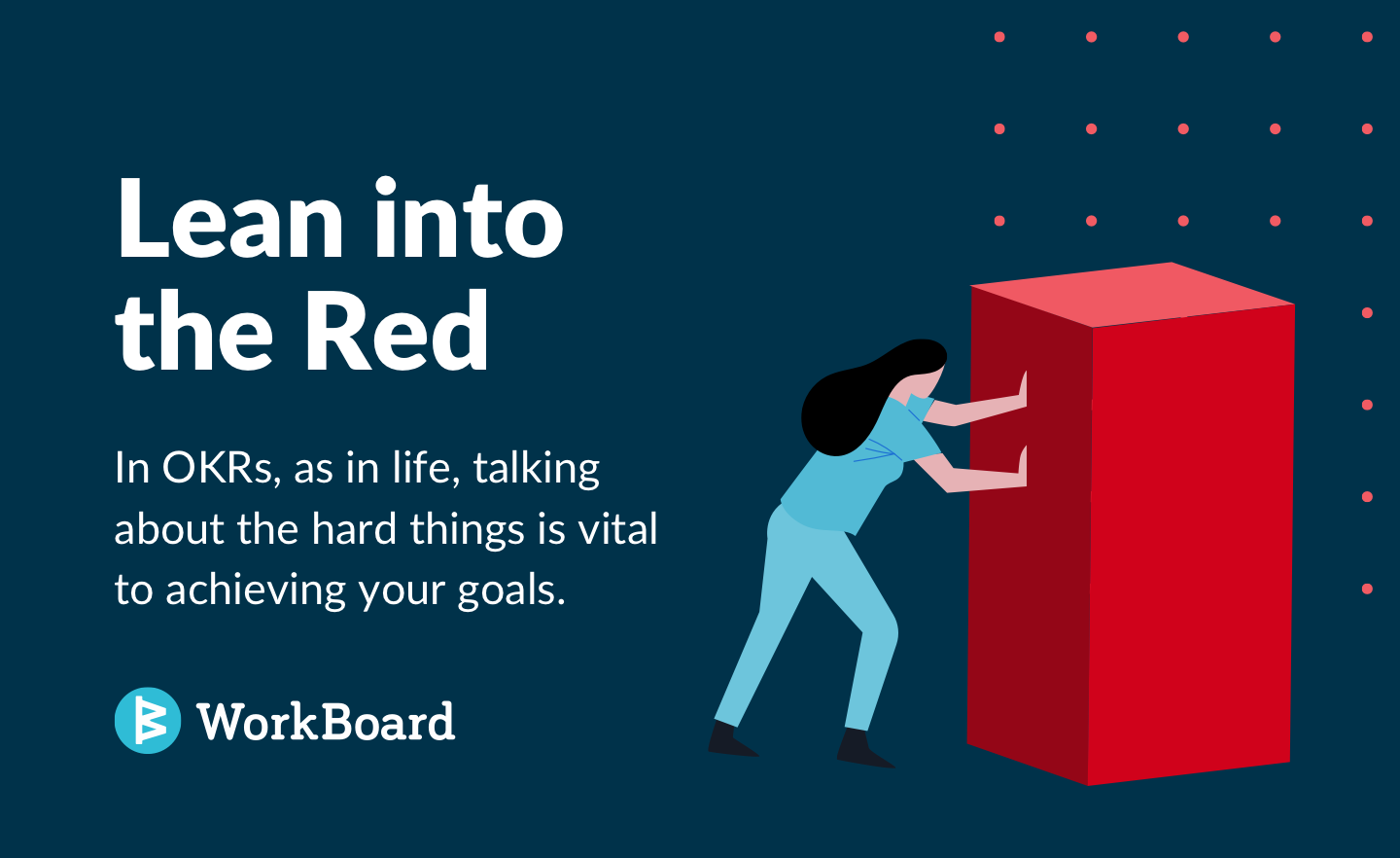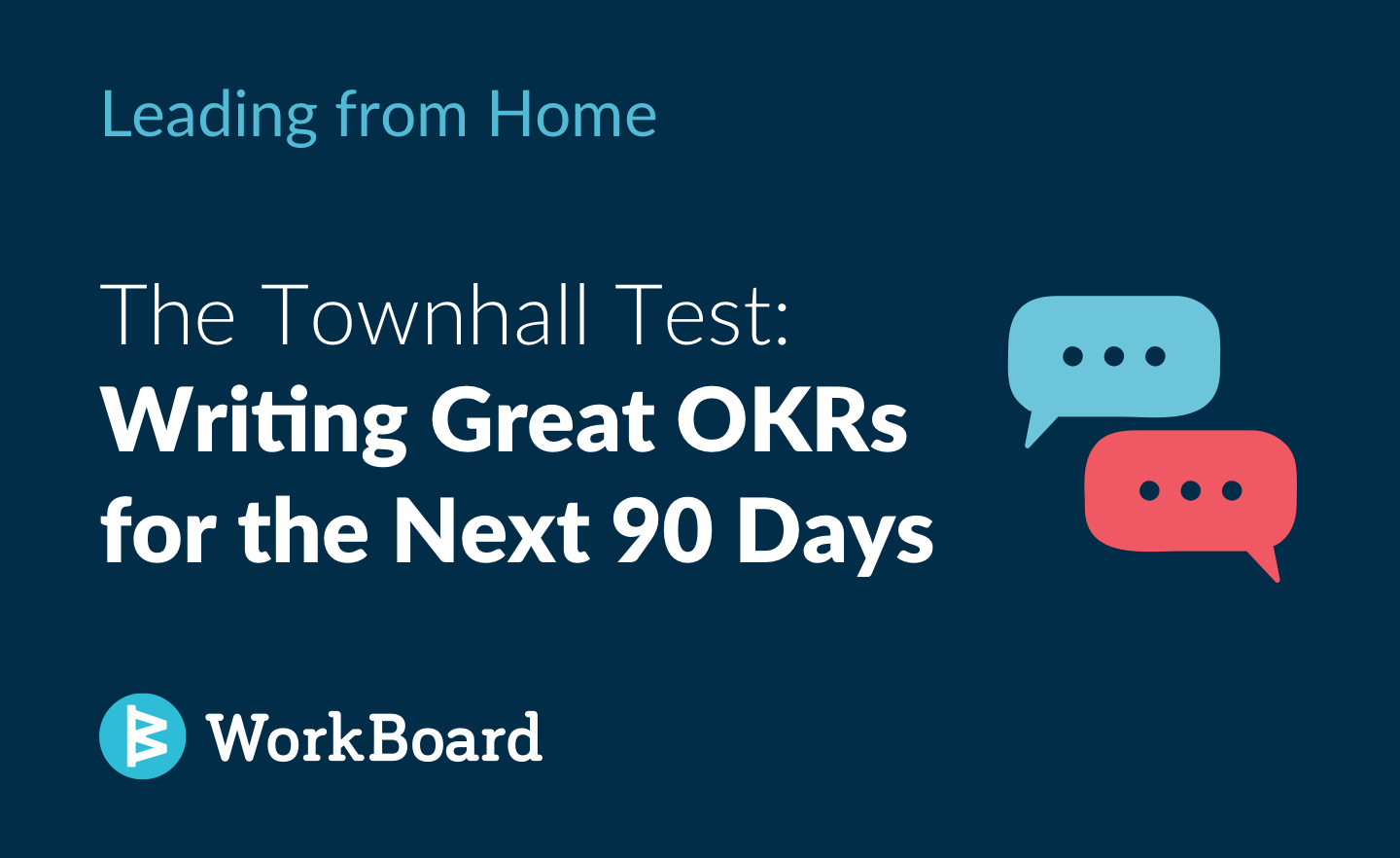
Editor’s note: the following is adapted from the original podcast audio transcript.
Maggie Crowley: Do you struggle to get your team aligned around strategic priorities? I spoke with Deidre Paknad, co-founder and CEO of WorkBoard, The Enterprise Results Platform for OKRs for customers including Microsoft, Cisco, Zuora, Workday., and more, and backed by Andreessen Horowitz. Deidre was also a VP at IBM and was the CEO of multiple other startups. Basically. She's the authority on how to get your team aligned around goals. We discussed the value of OKRs for organizations and how to get your team excited about using them.
Thank you for joining me, Deidre.
I'm happy to chat!
What led you to be so fascinated by OKRs?
Great question. The story starts when IBM bought my last company. As we transitioned from a mission- and metric-aligned startup where everyone was focused and moving in the same direction to the much larger IBM environment, I found it much more difficult to maintain that focus — and the growth it helped spur on. I realized that we wouldn’t continue to grow as fast if everyone wasn’t as aligned as we were as a smaller organization and that it definitely wasn’t going to happen with me using PowerPoints.
It seems from the outside looking in that bringing structure to the larger IBM environment would be a Herculean task.
Large companies like IBM or our WorkBoard customers already have processes or practices in place to clarify strategic priorities and drive alignment to, and accountability around, them. Of course, that might mean thousands of slides in PowerPoint decks, all of which are completely stale by the time they’re presented in all-day meetings every month or quarter. Big decks in big meetings where everyone is behind on the facts seemed like an incredibly manual and cumbersome output without a commensurate outcome.
And that business process is where I thought the huge opportunity existed — everyone at a company should be able to see the company’s strategic priorities and know if everyone is heading in the right direction and how they’re doing on that strategy in one second, definitely not in one month. That kind of alignment on strategic priorities, on what success is and how we’re going to measure it and drive the results and the risks as fast as possible so we can drive growth as fast as we can — that process should be your best process.
WorkBoard was created as an answer to this pain point, among others — that business process should be automated, reliable, data-driven, and transparent. It should be at least as reliable and data-driven as the help desk ticketing process is for most companies. After all, it’s the one your board cares about most!
How did you go about distilling that process down and making it accessible to everyone in an organization?
The distilling it down is what making software, which I have a career around, is about to me. Thinking about what a process looks like versus how it should look ideally and understanding where the friction is between the two. That includes understanding what the medium is now, what the latency in the current process is, and where the edge of it is.
For alignment, one of those edges, a place where big decks and big meetings breaks, is with what I'll call it the trickle-down effect.
In a company like IBM, where you’re using decks and tracker sheets to align five or six layers, it'll take a whole quarter to have priorities trickle down just because of the tools or the medium being used.
If the leader at the top has 10 directs and those 10 directs have 10 directs and then those 10 directs have 10 more directs, the volume increases as you go through the org, and alignment becomes increasingly difficult — especially lateral alignment, which is where all the juice is. Lateral alignment is almost impossible with PowerPoint or spreadsheets or Google Sheets and Google trackers. People have to work too hard to go find what the other teams to the left and the right are working on, so they don’t bother. So those people, those teams, put forth the effort, but they don’t get the magic from that effort that clarity and lateral alignment could provide in terms of achieving outcomes rather than accomplishing output.
I look at that missed opportunity as a workflow problem and a data transparency problem. That’s the friction — that the linkages between the objectives and key results at the top and the middle and in the wide part of the organization aren’t obvious. Removing that friction, providing people with clarity on how they can make the biggest impact on the company’s strategic priorities — that’s perfect for software.
I've never heard anyone talk about the fact that it's not just managing up to your leadership team, but it's also managing across and making sure other people know you're working on.
CEOs, in particular, are really aware of how powerful lateral alignment is and, especially for SaaS companies, that it’s actually the secret to high growth retention, high ARR growth, and high net retention.
Lateral alignment means that what sales is selling is the same thing marketing is marketing; the same thing product is building, the same thing the services team is deploying and driving value around. Where we get high churn is when sales sold whatever they could to make their number while marketing is messaging something else and product is building what they think is cool (but is unrelated to what marketing and sales are doing) and services is just ticking a checklist to get it done fast.
That misalignment means the customer never got the value of what the sales team promised them in the first place — and product was never even building what was sold! Imagine if you’re in a company with 10,000 products! This kind of “go your own way” scenario is painfully common, almost ubiquitous.
But lateral alignment, even with all its obvious advantages, takes focus to achieve. This is where OKRs come in at the team level, not at the individual level I should mention. Team OKRs surface what the team is trying to achieve and how they define success. Individual OKRs often reinforce low alignment on the team, where it’s everyone for themselves, and everybody's doing their own little thing.
Team OKRs within canonical teams are great. But what a lot of our big enterprise customers find really powerful is setting OKRs not on a functional team at all, but with a pod or squad of people who need to come together to make something happen. It may be a go-to-market team that includes a revenue lead, a success lead, and a marketing lead who come together and decide what they’re trying to accomplish on a product, a launch, or a new foray into a new part of the market. And then having the autonomy to decide how they define success with OKRs that don’t need to belong with an individual owner or with a functional or hierarchical team. That blocking is really powerful, and we see a real performance difference in those dynamic teams. Those cross-functional, non-hierarchical teams, on average, do 10% better on their OKRs in a quarter than functional teams.
This is evidence that bringing the right people together — who are highly dependent on each other and have a shared understanding — allows them to achieve more collectively.
Real results velocity kicks in when those dynamic teams have an opportunity to bring focus, double-down, solve, remove risk, and triage week-to-week with each other. That week-to-week focus with each other on the results they all agreed on — that's magic.
How do you help people who exist inside of an org that doesn't work like this or feel like they're not in control of how the systems are set up?
It depends on who that person is. If they’re on team of five people, I think the value of spending two hours, or even 20 hours, to agree on what it is you're trying to achieve together and get clear with each other on how you're defining success and what outcomes you're trying to create is worth it when you consider that those twenty hours are leveraged against the 500 hours you all have in the quarter. Especially when it’s so possible to spend those 500 hours on a set of assumptions about what matters that can be horribly wrong.
I've definitely done that.
So even if you're a small team and the rest of your organization does not believe in clarity of purpose and alignment on impact, as an individual or team member who owns your own career impact or as a manager who wants to be great, it's worthy of the practice.
For larger companies, which for WorkBoard means Cisco, Comcast, Microsoft, etc., we have an OKR coaching service. Our coaches will come in and help facilitate the OKR sessions where teams are going to meet and decide what they’re trying to achieve — and create the objectives and the results. That coach is there to help people have productive conversations that include trade-offs, which are a fundamental part of the dialogue because they help everyone think about outcomes, not just deliverables. We also help them genuinely get aligned and identify who they need to tie-off with laterally. That coach can help bring about a smarter conversation faster, so higher Integrity OKRs get set in the first go-round.
And for managers, especially managers in the middle who haven't been managing or leading for a long time, the coach lets the manager be in the meeting listening and thinking while also ensuring that the other team members are sharing the authorship because they also share ownership of the OKRs. If the manager’s got the pen at the whiteboard, it looks a lot more like dictation, which creates a different outcome than if the team collectively got on the same page, made the hard calls, and loves where they landed — which provides way more momentum going into the quarter.
Our coaching service is particularly there for companies trying to get five hundred teams aligned in a quarter. We also have a coaching school, which trains people inside organizations who want to build their skills and be the internal coach to just get deep into what alignment looks like, and how to measure everything.
Because when people tell you “we can't measure what we do,” what they’re really saying is I don't know how.
Yeah, you can definitely measure. I spent a lot of time this past quarter having a really in-depth discussion with the engineering director I work with about our goals statement and if we got it right for the magnitude of what we wanted to change. I think other people thought that we spent too long on it, but I think it was critical for us to both buy into exactly what we were going to try to get done. We’ve stayed aligned on that throughout the quarter, and I think, looking back, that I would have invested twice as much time for that alignment.
I think that's totally the right call. Some people definitely get frustrated thinking the words don't matter, but, as leaders, of course the words matter. If we're not clear on our intention, we shouldn't move onto what we can measure — we don't know what we’re measuring or why!
Sometimes people are uncomfortable with doing that — I call it “messy” work because of the kind of thinking it requires and the discomfort it can provoke. But once people do it and see the outcome on the other side, it gets way easier. The time involved is fundamental to building agreement. And when there is agreement on what the intention is, then people can talk about what success means and looks like.
One of the mistakes we see teams make on OKRs occurs is that they identify the objective, the statement of the goal right at the top. Then, instead of key results being their measures of success, they'll assume that the next layer just picks up one result or metric, and then that becomes their objective for their goal. And I think what gets lost there is the intent. Now you're just down to the unit. You're down to what I think is the soulless number.
The investment in being aligned on the intention before we start talking about the measurement. That investment needs to happen for every team, not just the teams at the top. And then everyone can calibrate every month on what is meant to be accomplished.
So how do you help people? Obviously, we work in software. There are the stereotypical doubters on the team. How do you help coach people to get bought into this process? How do you help someone who is an individual contributor or maybe a lower-level manager understand the value if they're sort of skeptical of the perceived time it takes to get this done?
I find it helpful to incorporate what we already know about the adoption of software products. We don't expect every customer or every user to adopt at the same pace — and in the same way on the same day. There's a set of people who go first. Then there is a set of people who see that the first crew got real value and think, “oh, that value is interesting; I need that value. I’ll go now.” Then there's a set of people who need a lot more data. They need a bigger data sample of people who previously succeeded, and then they'll decide to go. It’s the classic adoption curve.
I'm sitting here with my mouth hanging open because, as a product person, I can’t believe that I didn’t even think about that! It makes so much sense.
When you think about it in that context, what’s so liberating is that you recognize that the early adopters create the fact base that allows more conservative people to follow. It gives them more evidence of benefit. And then fast followers create yet more evidence of benefit that allows the mainstream people to follow, which creates yet more evidence which allows the more skeptical people to follow.
When you try to roll out something like OKRs, you can't skip this step and worry about the slow adopters because you can't convince them without evidence of benefit or value. So instead, focus your energy on your early adopters, your fast followers, and the benefit that they're getting. And then take the evidence in that data and communicate the heck out of it because it creates the fact base that allows more conservative people who need to “see it before they believe it” to buy in.
In other words, don't waste any calories on people who don't get it yet. Instead, really invest your calories on people who can consistently describe the value and the impact — the why and what's in it for them. In my experience, particularly in tech companies, if the OKRs don't have integrity and feel like a process for the sake of process — and lots of teams do crummy OKRs, and it is just a process for a process — then nobody wants to do them.
There has to be a sharing of what's in it for them as a member of a team or as a leader of a team, a demonstration of how this helps them. The high integrity of the OKRs themselves, as well as the goals and the metrics, facilitate that sharing.
An example of this happened this week. There was a moment where a team remarked that they made a lot of progress on one key result, but at the same time realized the need to refocus because they didn’t pick the right frame for how they were going to approach their other goals and their overall statement for the quarter. They’re trying to make their customers successful, and they had a proxy metric in between the end customer and what they were building and they realized they should have been looking at another top-line goal. So the epiphany was that there's a better way they could be working to impact that number more directly. To me, that was a really good sign that the teams were using their OKRs as a tool to think about how to have maximum impact. They stopped and asked if they were focusing on the right stuff rather than adhering to a rigid framework that they couldn't deviate from.
Yeah. I love that! I think, when done well, the process causes that conversation to happen every quarter. It causes everyone to stop and think if they are measuring right, if this is really where value is created. I think, if you build that muscle, then teams having that conversation consistently come back with the realization that they need to move closer to somewhere else that would give them better impact. When every team can do that, I think you have a smarter, faster organization.
Definitely. You said something earlier about managers and outcomes versus outputs that really interested me. Can you tell me a little bit more about that?
Yes, I think the exec team and certainly senior leaders tend to talk about outcomes — the business outcomes, our ARR, GRR, NRR, ACV. They think in terms of measurements and improvements. They’re spending dollars and allocating people and building products and driving training — all of those things to move the needle on ARR, ACV, etc.
But when you go to the director level and the rising managers, they're much more fluent, and often more comfortable, with talking about their output, but less so with talking about the outcomes that output will drive. That gap between output and outcome is another form of misalignment. Because you and I both know that a ton of activity doesn't always add up to value created. And people are exhausted — they did it all, were super busy...but it didn’t add up to the results the next level in the company wanted, or the results that would actually move the company's growth forward.
So I think it's just acknowledging that, if someone rises up from the individual contributor forward and starts managing a team or is a team lead managing work, which is what we're asking them to do, their day-to-day focus is often on output — and that brings us back to coaching.
Coaching builds comfort around the conversation people need to have on aligning effort to results, to outcomes. A conversation about how each result actually adds up to the results the company is trying to achieve and if they are aligned.
Because often they're not aligned, and there's a gap between effort and impact. In that gap, people see that they did a lot of work, but it didn’t matter, which honestly doesn't feel very good. And so I think helping people see the difference between output, which is the work we do, and outcomes, which is the value the work creates - the value we intend for the work to create, is crucial. Changing the conversation is crucial. What I like about key results is that they are actually about quantifying the outcome, not listing the output. It's a shift in conversation.
I often think that the hesitancy around that shift is based in fear, because there’s a transition from being able to say “I did all the inputs correctly and maybe the outcome didn't happen, but I did my job” to — as you grow in your role and in your leadership — being accountable to those results not being able hide behind “well did all the stuff I said I would do, so I get a gold star.”
Yeah, I think for some people, that’s it for sure. As a CEO and a business leader, I look at it as my job to coach and make sure that managers in the company and in the team have the skills to help their team get aligned on outcomes. And to coach managers or rising managers to drive accountability for outcomes, which is actually the job. Leadership should be helping rising managers be good at this as opposed to expecting them to magically go from awesome coder to maverick manager who knows everything. It’s the leader’s job to coach them up.
Seems like this should be the end of the piece. Especially since Deidre’s answer to the next question is garbled on the audio.
I could spend all day talking about OKRs, but we’re about out of time. For my last question, I'd love to hear what you're reading or listening to these days.
I just finished Ben Horowitz's new book, which I love. I was a huge fan of his book “The Hard Thing About Hard Things” of course. And I have “Sapiens” next on my iPad — I've heard so many awesome things about the book and its provocative way of thinking about how we come together as people, how we organize and coalesce. How we communicate, how we connect. So I'm super excited to crack that open tomorrow morning on my Peloton.
Yes. I also have a Peloton. I'm actually sitting by it right now — shout out to Peloton!
Deidre, thank you so much for coming on the show. I really appreciate you taking some time to chat about OKRs and giving us some knowledge on how we can be more outcome-focused and do this process better.
Oh, absolutely. It was very fun. I love the topic, and it was great to talk about it with you. Thanks.









